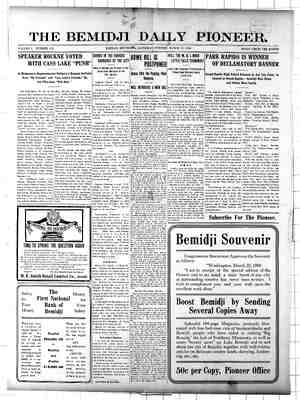Bemidji Daily Pioneer Newspaper, March 27, 1909, Page 18
You have reached the hourly page view limit. Unlock higher limit to our entire archive!
Subscribers enjoy higher page view limit, downloads, and exclusive features.
BEMID.JT, BFL'I‘ SXMBITH AT FOUNTY FAIR. BEMIDJI, BELTRAM! CO. oS ARDSON 1t LHOTABERIOY, A\\II COU\ITY \\ID l\OR’l‘HFR\I MI\I\IEQOTA PRODUCTS OF CUT-OVER LANDS OF BELTRAMI COUNTY, Exhibited at County Fair, Held at Bemidji, 1908. GREAT LAND VALUES IN BELTRAMI COUNTY The following article, which appeared in the columns of this paper under date of December 10th, 1908, is by a state official and hance authentic: George \Welceh, director of the state im- migration bureau, has prepared an address fer the Academy of Social Science of the Minnesota university, which says great things for the natural resourses and future of northern Minnesota, Mr, Welch tells of the opportunities awailing acceptance at a merely nominal price, in a most convincing way. “No greater field for velopment is to be found,” “than is offered by agricultural de- says Mr. Welch, this state. Minnesota has, approximately, 50,000,000 acres of land, 90 per cent of which is capable of agricultural production. Of this, not to ex- ceed 18,000,000 acres has ever been plowed.” Relative to north-central Minnesota, he says: state is but people of Minnesota, inhabitants of other was originally covered forest, the popular opinion was all pine, but T am in- state engineer that not to cent of northern Minnesota pine on it. “The northern section of our little known to the and not at all to the states, Thig region with a dense being that it formed by our exceed 10 per ever had “I mention this because it is a popular im- pression that pine grows only upon sandy soil—which is erroneous in the extreme. Pine timber may be found on soil so sandy that it is valuless except for reforestation, and it may be found on the heaviest of clay goil. Tests have been made in this dis- triet in the production of all kinds of pro- ducts, and it is today the universal opinion of those who know that there is no section in America that equals this nothern part ‘ | of Minnesota for production of root crops and tame grasses. “Nor do I wish to be understood that this section has failed to produce cereal crops, for such is not true; but the place to pro- duce any given commodity is where it can be produced the best and the cheapest, and for that reason I state that this region of Minnesota is particularly adapted for dairy products and root crops. I contend that a given tract of land in northern Min- nesota will pasture nearly double the amount of cattle or any other live stock that will (be the same area in the more highly developed sections of the Mississippi val- ley. “We have upwards of 6,000,000 acres of Jand in this region known as ‘swamp lands,” all of which can be easily drained; and as a large part of them are now de- nuded of timber, when drained, can be im- mediately turned into farms. This state is doing magnificent work in this direc- tion, which is aiding in a large measure the settlement of this district of Minne- sota. The cheapness of the land, the pro- ductiveness of its soil, the timber thereon which can be used for fuel and building material by the incoming settlers, makes this a most desirable location for a man of limited means to build a profitable farm home. “No better opinicn can be formed of the capabilities of Minnesota to produce agri- culturally than by a short review of what she has accomplished. In 1858 the entire farm products of the state amounted to less than $7,000,000, while in 1907 the com- bined products of the farms amounted to $265,000,000. nothwithstanding the small per cent of land under cultivation. — “From the foregoing it will readily be secen -that there are two propositions con- fronting the Minnesota people to bring her agricultural products to where they should be; first, more people to till the soil; sec- ond, a more scientific method in tillage by gpecializing products.” In giving brief examples of wonderful showings made in northeastern Minnesota, Mr. Welch says: “G. G. Hartley of Duluth opened up a farm in the swamps of western St. Louis county, and after draining land which was not valued to exceed $4 per acre, the fol- lowing year produced on a tract of 10 acres, $10,000 worth of celery.” A FITTING CORROBORATION. We request the indulgence of your time to the extent of ‘“wading through this ar- ticle,” so to speak, in order that you may ¢et an inkling of the fabulous worth of the lands which form a part and parcel of Bel- trami county. As a prelude, let us Pioneer for many years has been the of- ficial paper of Beltrami county and the leading newspaper of this north country, as well as the recognized mouthpiece of Bemidji and Beltrami county. This being true, it is an accepted fact that whatever state- ment we make, broad as it may seem, is authentic and authoritative, and may, therefore, be relied upon as being well founded and truthful, state that The To commence with we ask the question: What is the value of farm land which contains a rich black loam from fourteen inches to three feet in depth, and a vig-




